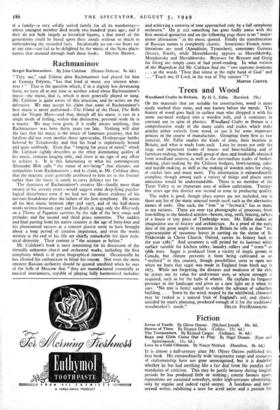Trees and Wood
Woodland Crafts in Britain. By H. L. Edlin. (Batsford. 15s.)
OF the materials that are suitable for construction, wood is more easily worked than stone, and was known before the metals. The history of wood goes back to earliest man who chopped it with his stone axe-head wedged into a wooden haft, and it continues in constant use in spite of plastics. Woodland Crafts in Britain is a comprehensive study of the many crafts and trades which make articles either entirely from wood, or use it for some important process in the course of manufacture. Grouping them first as raw material, Mr. Edlin studies the kinds of trees, their location in Britain, and what is made from each. Later he treats not only the large and important trades of house- and boat-building and of furniture-making, but the small group of dyes and foodstuffs obtained from woodland sources, as well as the intermediate trades of basket- making, chair-making by the Chiltern bodgers, bowl-turning, rake- and hurdle-making, as well as the making of wooden soles for clogs, of cricket bats and many more. The information is extraordinarily complete, though among such a variety of things and places some omissions would be understandable. There is no mention of the Trent Valley as an important area of willow cultivation. Twenty- five years ago this district was second to none in producing quality.
The index is good, though place names are not included, nor i, there any list of the many unusual words used, such as the alternative names of tools. One such, the "froe" or " fromard," has as many as ten variants. There are over 15o photographs of processes, from tree-felling to the finished articles—besom, trug, swill, fencing, rafter, of a house or tiny piece of Tunbridge ware. Mr. Edlin makes an imaginative use of history and architecture. As a proof of the early date of the great maple or sycamore in Britain he tells us that " the representation of sycamore leaves in carving on the shrine of St. Frideswide in Christ Church, Oxford, carries its history back to the year I282." And sycamore is still prized for its lustrous white surface suitable for kitchen tables, laundry rollers and " treen" or table ware. Sugar is produced from a variety of maple grown in Canada, but climate prevents it from being cultivated as an "orchard" in this country, though possibilities seem to open out when we learn that sugar was made in England from birch sap in 1675. While not forgetting the diseases and weakness of the elm. he points out its value for underwater uses, or where strength is required, such as for the hubs of wheels. He explains its frequent presence in the landscape and gives us a new light on it when he says: "No tree is better suited to endure the advance of suburban building.... Sown by the wind, reaped by the whirlwind, elmwood may be ranked as a natural fruit of England's soil, and chance, unaided by man's planning, produced enough of it for the traditional


































 Previous page
Previous page